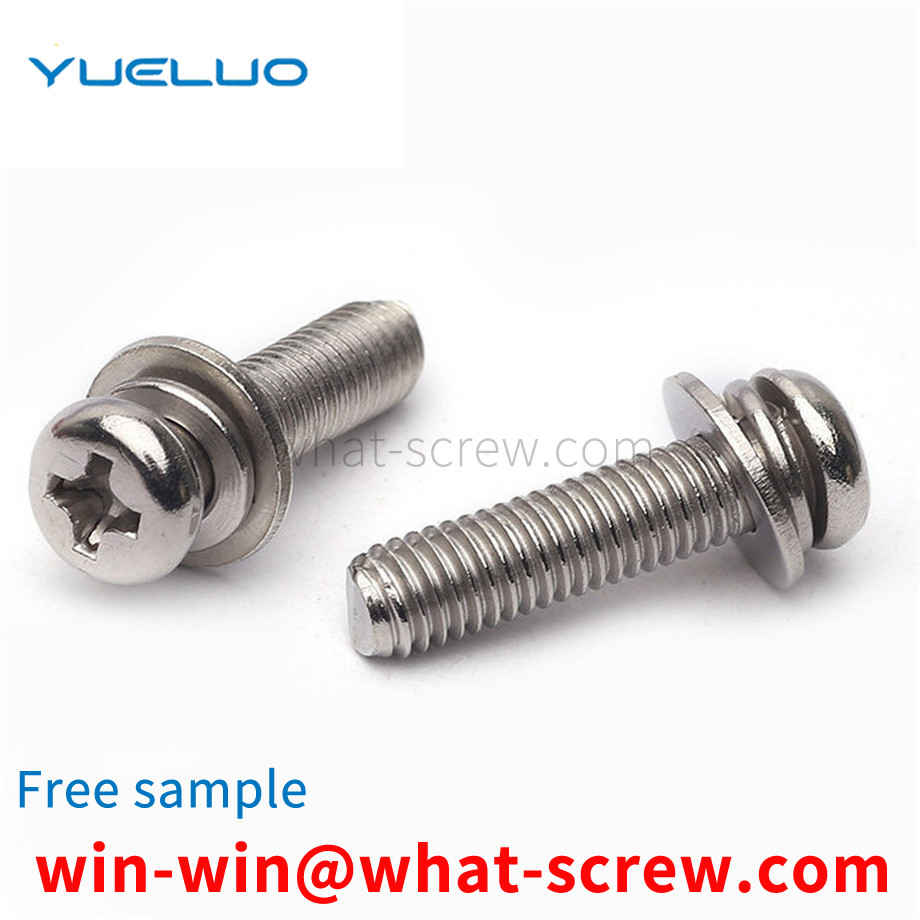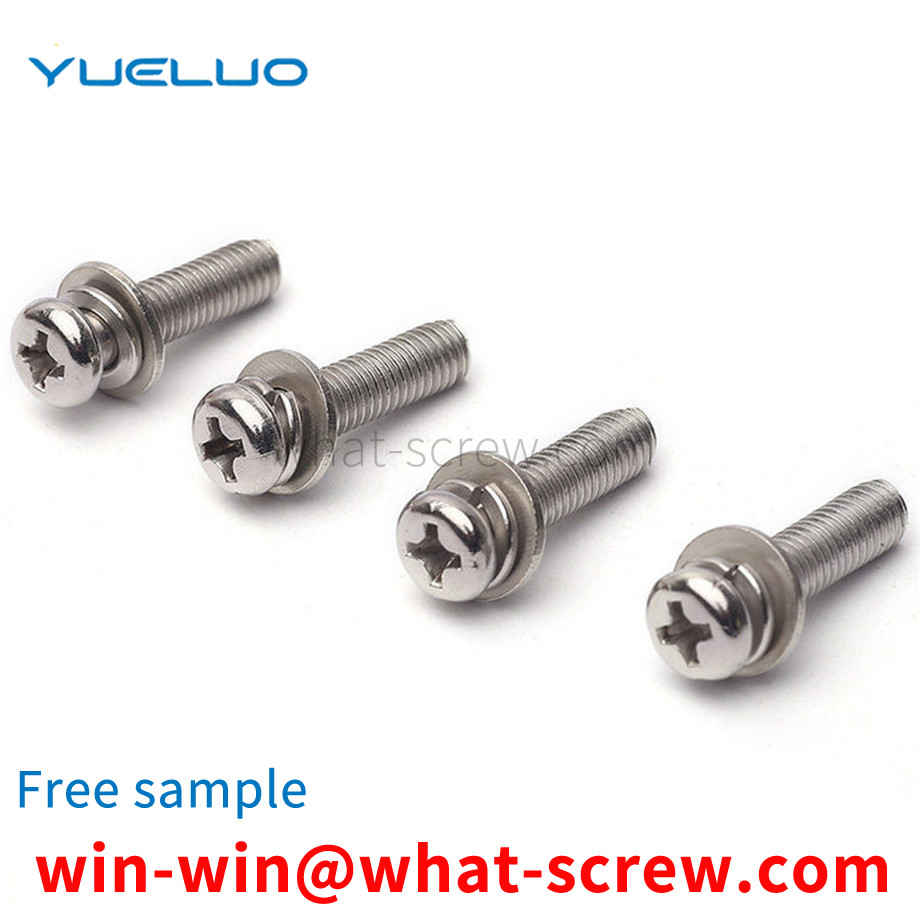1. The expansion phenomenon of the spring washer is generally not the problem of the spring washer itself. 2. The spring washer with the expansion ring must be subjected to a radial external tension. The external tension is derived from the tightening axial force generated by the tightening torque. The chamfer creates a radial component of the axial clamping force, which expands the opening of the spring washer. The smaller the chamfer diameter, the greater the possibility of ring expansion. 4. Adding a flat washer between the nut and the spring washer helps to slow down or prevent the expansion of the ring, but the flat washer is too thin or too soft. Prevent ring expansion 5. The reason for the hydrogen embrittlement fracture of spring washers is generally due to unreasonable heat treatment process and the failure of hydrogen removal treatment after electro-galvanizing. A large number of tests and long-term practical experience have confirmed the above analysis.
It can be seen from the extrusion process that the screw works under high temperature, certain corrosion, strong wear and high torque. Therefore, the screw must: 1) High temperature resistance, no deformation under high temperature; 2) Wear resistance, long life; 3 ) Corrosion resistance, the material is corrosive; 4) High strength, can withstand large torque, high speed; 5) Good cutting performance; 6) After heat treatment, the residual stress is small, and the thermal deformation is small. [1]
T-bolt is a common fastener, which is mostly used where there is a T-slot on the workbench or where the connection can only be made from the side to be connected. However, it has the following problems in the actual production and processing process. 1. The T-bolt manufactured according to the current GB37-88 is used in conjunction with the T-slot on the worktable, which is easy to damage the T-slot on the worktable. 2. According to the observation and investigation, it is found that 90% of the damage to the T-bolt manufactured by GB37-88 is thread damage during use, and the T-shaped part is rarely damaged, resulting in a waste of raw materials. SUMMARY OF THE INVENTION The purpose of the present invention is to solve the problem that the current composite T-bolt is easy to damage other equipment and cause waste of raw materials in the actual use process, and to provide a simple structure, easy to use, safe and reliable, and not easy to damage other equipment. , thereby saving raw materials and other advantages of composite T-bolts. In order to achieve the above purpose, the present invention adopts the following technical scheme: a composite T-bolt, which includes a bolt, and one end of the bolt is connected with the T-shaped block cockroach. The T-shaped block is provided with a tapered hole, and the connection between the bolt and the T-shaped block is a cone, which is matched with the tapered hole. The utility model combines the two parts of the T-shaped block and the threaded bolt through the T-shaped block and the taper hole and the cone on the bolt to automatically lock the two parts before use. When the threaded part of the bolt is damaged, only the threaded bolt needs to be replaced. That's it. Compared with the domestic T-shaped bolts currently produced in the manufacturing process, the utility model solves the problems of complicated manufacturing processes and waste of raw materials. It is well known that the manufacture of T-bolts requires processing such as forging, turning, milling, and heat treatment. Since the composite T-bolt is used in combination with the T-block and the bolt, and the T-block is rarely damaged, after purchasing or manufacturing the T-block once, you only need to purchase or manufacture the bolt in the future. Compared with the T-bolts currently produced in China, the composite T-bolts can better protect the T-slots on the working surface. Because the T-bolt currently produced in China will rotate a certain angle around the axis of the T-bolt when fixing the object, the T-bolt will rotate at a certain angle, thereby reducing the contact between the T-bolt T-shaped surface and the T-slot stress surface of the working face. surface, causing stress concentration on this surface. The composite T-bolt avoids the above problems due to the increase of the guide surface, thereby protecting the T-slot. The beneficial effects of the utility model are: 1. Saving raw materials. 2. Reduce processing costs. 3. Simplify the technological process. 4. Protect the T-slot.
When using screws, if you can understand the mechanical properties of screws first, then you can use screws better. Different types of screws have different mechanical properties, and the different mechanical properties lead to different occasions when screws are used. 1. Self-tapping screws: mechanical performance requirements 1. Heart hardness: standard value HRC28-38. When testing, take the section 1-2 times the diameter of the name from the tail. If the length of the name is too short, it can be embedded first, and then the hardness is measured. 2. Surface hardness: standard MIN HV450. 3. Carburized layer: standard 4#-6#: 0.05-0.18mm, 8#-12#: 0.10-0.23 mm, 14#: 0.13-0.28 mm. The main purpose of carburizing is to enhance the surface hardness and ensure the strength of the teeth. If the decarburization is too deep and the carburization is insufficient, the strength of the teeth will not meet the requirements, that is, the teeth will be damaged during the screw-in test. 4. Torque: standard specification 4#5#6#7#8#10#12#14#A tooth 14212835455696145AB tooth 142128354565102165. 5. Screw-in test: screw the self-tapping screw into a steel plate with a reserved test hole. The self-tapping screw should form a matching thread in the test plate, and the thread of the screw itself will not be deformed or damaged until the end. Tapered threads pass completely through the test plate. The screw-in test is only applicable to AB, B, BP and other types of self-tapping screws. It is stipulated in IFI that the test plate shall be prepared from semi-hard low-carbon cold-rolled steel, and the hardness of the steel plate is 70–85HRB in Rockwell. The standard specification of the steel plate, that is, the thickness, is shown in the table below. The test hole should be punched or drilled, and the tolerance is the specified nominal diameter (see the table below) ± 0.025mm. Specifications 6#7#8#10#12#1/4 Test plate thickness (mm) 1.85-1.953.12-3.234.68-4.84 Aperture (mm) ±0.0252.953.263.454.044.765.50.
In the process of driving the car, it is inevitable to use the brake frequently, which will cause the gap between the brake drum and the friction pad of the car to become larger. Therefore, it needs to be adjusted in time, otherwise, the hidden danger of unsafe driving will be buried due to the excessive braking distance and the out-of-round brake drum. Therefore, motor vehicles must be equipped with automatic adjustment arms. In the existing automatic adjustment arm, the worm inside the housing is limited by the spring pad, the spring and the spring cover, and the end face of the spring pad is directly in contact with the worm, and the rotation of the worm is inflexible due to frictional resistance during rotation.
We have many years of experience in the production and sales of screws, nuts, flat washers, etc. The main products are: semi-circular solid rivets, carbon steel galvanized semi-circular nuts, F60 screws, Dongguan flange nuts and other products, we can provide you with fastening suitable for you piece solution.



















 Service Hotline
Service Hotline




